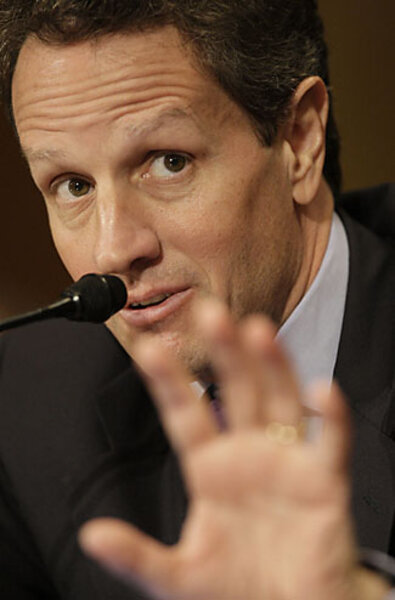Is a 'bad bank' for risky assets the solution to the financial mess?
Loading...
With the financial crisis now midway through its second year, a central problem for the US economy remains: how to convincingly clear away a garbage-pile of bad debts at banks and move forward with a solvent industry.
A leading idea under review by the Obama administration is to set up a so-called "bad bank" as a holding pen for the risky assets that spawned the crisis. Administration officials have talked about this concept, and have said they want to avoid temporarily nationalizing some very large banks.
No fix is easy. Every option comes with questions about its cost to taxpayers, its political support, and – most important – whether it will work.
Obtaining the assets to put in a bad bank while avoiding a federal takeover of the largest troubled banks raises the same challenge that the Bush administration ran into when it launched the $700 billion Troubled Asset Relief Program (TARP) last October.
The problem?
It's not easy, or cheap, for the government to buy up bad assets. If it doesn't succeed in removing enough of those assets from the banks, the crisis may linger.
What has been happening in recent months follows a familiar pattern from past financial crises around the world. If addressed too tentatively, banking problems deepen and become more expensive to resolve. The remaining TARP money – the second $350 billion now being sought by President Obama – may not be enough to fix the system.
"He could be about to make a big mistake, unless the government winds up owning maybe 80 or 90 percent" of some of the institutions it rescues, says Pete Kyle, a finance professor at the University of Maryland.
By taking a large ownership stake in these institutions, the government and taxpayers stand to reap benefits if the banking system recovers as they shoulder the risk of big losses.
Even then, it's a fair question why the government should have to pay for the troubled assets of banks that, without assistance, would fail.
The costs of reviving the economy, including the bank rescues and a stimulus plan now moving through Congress, are reaching gargantuan proportions above $1 trillion. Purchasing troubled assets would only add to those costs, which also may include pumping additional new capital into banks once the troubled assets are removed.
US banks will need to charge off about $1 trillion in losses this year, estimates Institutional Risk Analytics, a firm that tracks the health of banks. Since America's bank assets are heavily concentrated in the very largest banks, and since those banks are the ones that took some of the largest risks, some two-thirds to three-quarters of that loss will land at four banks, the firm estimates.
Those large banks, ranked from the biggest losses on down, are Citigroup, followed by Bank of America, JP Morgan Chase, and Wells Fargo.
These banks are all in the camp considered by many to be "too big to fail," but some analysts say that doesn't mean that one or more of them couldn't be temporarily taken over by the government, if conditions warrant.
"I don't think there's any stigma associated with nationalizing a bank, if it opens the next day as a sound institution," Mr. Kyle says.
Nationalization wouldn't necessarily disrupt day-to-day operations at banks. Bad assets could be stripped out, new capital put in, and the bank could continue to operate with its current staff.
After a time the company – as a whole or in parts – could be sold to other banks or refloated with a new public stock offering, with the proceeds helping to cover the costs of government assistance. Similarly, the bad assets could be gradually sold off over time.
If the Obama team decides that these big banks must not go that route, part of the reason may be the fallout from last fall's failure of the investment bank Lehman Brothers.
The tide of fear that rippled through financial markets after Lehman's bankruptcy – in part the fear of who might be next – is something that officials don't want to repeat. The economy worsened dramatically in the wake of that event.
It's possible that fear would spread among investors in other banks if shareholders of a big bank were wiped out in a nationalization.
This risk highlights the difficult choices facing Obama and his advisers.
At this point, fixing banks is a vital part of any economic recovery, but it is just part of an overall revival plan.
Claims for new unemployment benefits came in higher than expected in a weekly report Thursday, and new-home sales hit a historic low. This explains why Obama is also pushing an overall government spending and tax-cut package to support the job market, and why he's preparing special proposals to ease pressures on the housing market.
In this environment, some observers say separating good assets from bad in the banking industry is no simple task.
Meredith Whitney, a bank-industry analyst at Oppenheimer & Co., writes in a new report that losses from the troubled assets – structured securities largely tied to the housing market – are "only one challenge related to the commercial banks." The banks also face rising losses this year on everything from credit cards to business loans because of the recession.
A bad bank would not constitute Obama's entire plan for restoring a healthy financial system. But it could play a central role.
That means facing the question of how to acquire troubled assets. If the government pays too high a price, taxpayers are effectively subsidizing bank shareholders. If the price is too small, Ms. Whitney says it will be hard to attract enough assets to relieve uncertainty about banks' health.






